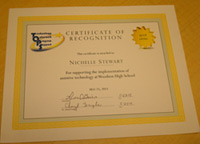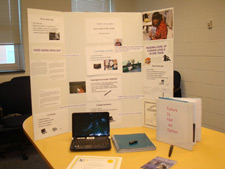- Active small-group collaborationUp to eight students can learn together at the same time, interacting with activities on the multitouch surface.
- Accessible for allThe horizontal, 360 degree surface makes it easy for all students to participate, including students in wheelchairs or with limited motor skills.
- Designed for the active classroomThe sturdy pedestal prevents tipping by even the most enthusiastic learners. The SMART Table can support 200 lb. (90 kg) on its scratch- and spill-resistant surface.
- Engaging, interactive contentAccess ready-made content for preK – 3 from the SMART Exchange website. You can also create new activities using the SMART Table Toolkit or import SMART Notebook files.
As exemplified above from Smart technology, the Smart table is perfect to engage and personalize programs for your learners. The table is also adjustable which is great for wheelchair bound students.
Simultaneous multitouch capability
|
SMART Table supports up to 40 simultaneous touches, enabling eight students to collaborate on lessons at the same time. It also supports simple, intuitive gestures like rotate, toss and zoom.
|
|---|---|
Extensive content and resources
|
SMART Table comes with over 1,500 ready-made activity packs. You can download them for free from the SMART Exchange website™, which can be accessed directly from SMART Table. The SMART Table Toolkit makes it easy to create and enhance SMART Table activities. You can also import SMART Notebook lessons, so you can use the same lessons you create for your SMART Board™ interactive whiteboard on your SMART Table.
|
High-quality display
|
SMART Table features a 42" (106 cm) LCD, 1080p display that is virtually free of shadows and glare. The images are sharp, the colors are vibrant and students can work in almost any lighting conditions.
|
Rugged design and easy set up
|
The sturdy pedestal prevents tipping by even the most enthusiastic learners. The SMART Table can also support 200 lb. (90 kg) on its scratch- and spill-resistant surface. Set up is easy – the SMART Table can go from the box to being in use in 30 minutes.
|
UDL friendly
|
SMART Table was designed with Universal Design for Learning (UDL) in mind, giving you the flexibility to provide multiple ways for students to interact with lesson content and express their knowledge. You can also develop and personalize interactive content to accommodate students with special needs.
|
Mobile design
|
SMART Table is designed to fit through standard doorways, so it's easily moved from classroom to classroom, allowing one school to share interactive learning centers between multiple rooms. Optional casters are available.
|
Bring objects to life
|
Connect a SMART Document Camera to SMART Table to capture and display images and video. If you have a SMART Notebook file with 3D content in your activity pack, you can use the SMART Document Camera with a Mixed Reality Cube to manipulate the content.
|
Free training and support
|
A wide variety of training and support options are available to help you get going quickly and start experiencing the full benefits of your SMART Table.
|
Share SMART Table content with the whole class
|
The SMART Table comes with a free license for SMART Sync™ classroom management software, which enables you to share SMART Table content with the whole class via the SMART Board interactive whiteboard. You can also send activities from your own computer to SMART Table.
|
http://youtu.be/WaUxBkkvcmE link for video tutorial Source: smarttech.com Source: Dell, A; Newton, G and Petroff, J. (2012). Assistive Technology in the Classroom: Enhancing the School Experience of Students with Disabilities. Pearson Education. | |

